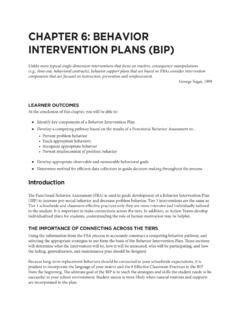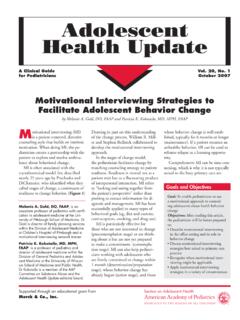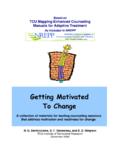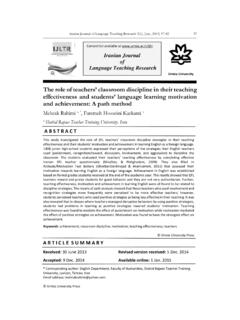Transcription of The Theories of Reasoned Action and Planned Behavior ...
1 The Theories of Reasoned Action and Planned Behavior : Examining the Reasoned Action Approach to Prediction and change of Health Behaviors Christina Nisson Allison Earl University of Michigan To appear in K. Sweeny & M. Robbins (Eds). The Wiley Encyclopedia of Health Psychology The ability to understand the fundamental causes of public health problems and develop interventions to address those problems is important to a range of researchers involved in the study of health psychology. Two of the most widely tested models of this nature are the Theory of Reasoned Action (Fishbein & Ajzen, 1975; Ajzen & Fishbein, 2005) and the Theory of Planned Behavior (Ajzen, 1991; Ajzen & Fisbein, 1980, 2005). The Theory of Reasoned Action posits that Behavior is a function of behavioral intentions that are, in turn, a function of attitudes and subjective norms (see Figure 1).
2 The Theory of Planned Behavior took the components of the Theory of Reasoned Action , but added perceived behavioral control as an additional factor predicting both behavioral intentions and Behavior (see Figure 2). In recent years, these models have been collapsed under the umbrella of the Reasoned Action Approach (see Figure 3). Description of the Models Both the Theory of Reasoned Action and the Theory of Planned Behavior developed out of a theoretical tradition that considered attitudes as a major influence on human Behavior (Smith, 1932; Stagner, 1942; Thurstone & Chave, 1929). However, other contradictory research emerged suggesting the link between attitudes and Behavior was tenuous at best (Corey, 1937; La Piere, 1934; Vroom, 1964), with some researchers even calling for abandonment of the attitude construct altogether (Wicker, 1969).
3 However, Fishbein and Ajzen (1974) noted that the inconsistency between attitudes and behaviors could be improved by measuring attitudes and behaviors at the same level of specificity. Thus, rather than using global attitudes ( , attitudes toward religion) to predict specific behaviors ( , church attendance the following Sunday), Fishbein and Ajzen (1975) posited that researchers should focus on the specific antecedents of specific behaviors ( , attitudes toward church attendance the following Sunday predicting church attendance the following Sunday). Furthermore, Fishbein and Ajzen (1975) posited that the link between attitudes and Behavior might best be explained by an appeal to specific behavioral intentions. That is, attitudes about performing a Behavior would predict behavioral intentions to enact the Behavior , which would in turn predict Behavior .
4 In addition, because one may also take into account how others perceive one s actions, subjective norms about how to behave were also included as a predictor of behavioral intentions. Behavioral intentions were then were identified as the best predictor of Behavior (Fishbein & Ajzen, 1975). In this model, attitudes toward the Behavior were defined as an aggregate of readily accessible or salient beliefs about the likely outcomes of performing the target Behavior , whereas subjective norms were defined as the perceived social pressure to perform or not perform the target Behavior , and behavioral intentions were defined as the perceived likelihood of performing the target Behavior . However, one factor that may limit the translation of intentions to Behavior is one s ability to enact the desired Behavior .
5 As such, the Theory of Planned Behavior updated the Theory of Reasoned Action to include a component of perceived behavioral control, which specifies one s perceived ability to enact the target Behavior . In fact, perceived behavioral control was added to the model to extend its applicability beyond purely volitional behaviors. Prior to this addition, the model was relatively unsuccessful at predicting behaviors that were not mainly under volitional control. Thus, the Theory of Planned Behavior proposed that the primary determinants of Behavior are an individual s behavioral intention and perceived behavioral control (see Figure 2). As such, according to the Theory of Planned Behavior , behavioral intentions are framed as the motivational component of the model, or one s conscious plan or decision to exert effort to perform the target Behavior .
6 Behavioral intentions are determined by attitudes towards the Behavior ( , whether engaging in the Behavior is evaluated to be positive or negative), subjective norms surrounding the Behavior ( , beliefs about whether others think one should engage in the Behavior ), and perceived behavioral control ( , beliefs regarding how easy or difficult performing the Behavior is likely to be). In this context, perceived behavioral control reflects both external factors ( , availability of time or money, social support) as well as internal factors ( , ability, skill information). In other words, low perceived behavioral control exists in situations in which performance of the target Behavior is dependent upon a number of other factors, which may or may not be within an individual s control. For example, one may experience low perceived behavioral control for the target Behavior of eating healthy if constraints such as time, affordability, access, and temptation are viewed as obstacles to engage in the Behavior despite high intentions.
7 As a result, the higher the perceived behavioral control for a target Behavior , the higher the predictive power of behavioral intentions for that Behavior . In recent years, the Theory of Reasoned Action and the Theory of Planned Behavior have fallen under the umbrella of the Reasoned Action approach (Ajzen & Albarrac n, 2007; Fishbein & Ajzen, 2010). As seen in Figure 3, the Reasoned Action approach encompasses all of the components proposed by earlier models ( , attitudes toward the Behavior , subjective norms, perceived behavioral control, and intentions), while also including additional factors such as actual control, defined as skills, abilities, and environmental factors that influence one s ability to enact a target Behavior . As such, the Theory of Reasoned Action and the Theory of Planned Behavior will be referred to jointly as the Reasoned Action approach throughout.
8 Ability to Predict Health Intentions and Behaviors A series of meta-analyses and reviews examining the application of the Reasoned Action approach to health behaviors have now been published, including those focusing on multiple health domains (Armitage & Connor, 2001; Conner & Sparks, 2005; Godin & Kok, 1996; McEachan, Conner, Taylor, & Lawton, 2011; Webb, Joseph, Yardley, & Michie, 2010) and those focusing on specific behaviors ( , exercise: Hagger, Chatzisarantis, & Biddle, 2002; condom use: Albarrac n, Johnson, Fishbein, & Muellerleile, 2001). Such reviews have shown the Reasoned Action approach to be a relatively successful predictor of health intentions and Behavior , explaining 32-44% of the variance in intentions and 15-41% of the variance in Behavior . One important moderator of the predictive ability of the Reasoned Action approach is Behavior type.
9 For instance, the Reasoned Action approach appears to be relatively more successful in the prediction of diet and exercise behaviors, as well as condom use. In a recent comprehensive meta-analysis, McEachan and colleagues (2011) found that the Reasoned Action approach was able to explain 21% and 24% of the variance in dietary and exercise behaviors respectively. At the same time, the Reasoned Action approach appears to be less successful at explaining the variance in addictive and clinical screening/detection behaviors. The same meta-analysis revealed that the Reasoned Action approach was able to explain only 15% and 14% of the variance in such behaviors respectively. It is not surprising that the Reasoned Action approach is better at predicting some behaviors than others. Looking at the categories in which the Reasoned Action approach is more versus less successful in predicting Behavior , it follows that the model is less predictive of addictive and clinical screening behaviors, as these behaviors are likely to be low in perceived and actual Behavior control, affected not only by personal motivation and desire but also other factors ( , biological aspects of addiction, access to treatment and health services, financial resources to engage in screening behaviors).
10 Along with Behavior type, there are also two important methodological moderators to consider when examining the ability of the Reasoned Action approach to predict health Behavior : length of follow-up and method of measurement (objective vs. self-report). The amount of time between measurement of Reasoned Action approach variables and assessment of Behavior is an inherent limiting condition of the Reasoned Action approach. Ajzen and Fishbein have repeatedly stressed that the measurement of Behavior should occur as close as possible to the measurement of the Reasoned Action approach variables as the model is only able to predict Behavior to the extent that the Reasoned Action approach variables remain consistent from the time of measurement to the time of assessment of Behavior (Ajzen, 1985; Ajzen & Fishbein, 1980; Ajzen & Madden, 1986).





